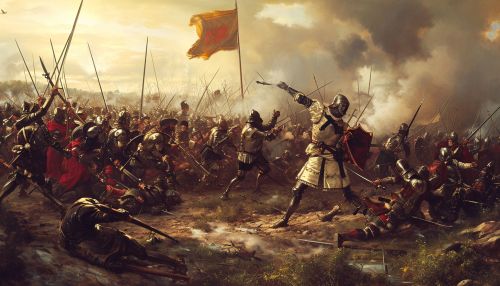Nine Years' War (Ireland)
Background
The Nine Years' War, also known as Tyrone's Rebellion, took place in Ireland from 1593 to 1603. It was a conflict between the forces of Gaelic Irish chieftains led by Hugh O'Neill and Hugh Roe O'Donnell, against the English rule in Ireland led by Queen Elizabeth I. The war was a culmination of a series of rebellions against English rule dating back to the 12th century.


Causes of the War
The primary cause of the Nine Years' War was the desire of the Irish chieftains to maintain their traditional rights and privileges in the face of increasing English control and colonization, known as the Plantation policy. This policy involved the confiscation of land from Irish lords and the settlement of English and Scottish colonists, which led to significant cultural and political changes in the region. The English crown's efforts to extend its control over Ireland, both through direct rule and through the manipulation of traditional Gaelic political structures, also played a significant role in the outbreak of the war.
Key Figures
Hugh O'Neill, the Earl of Tyrone, and Hugh Roe O'Donnell, the chief of the O'Donnell clan, were the main leaders of the Irish forces during the Nine Years' War. On the English side, key figures included Queen Elizabeth I and her military commanders in Ireland, such as Sir William Russell, Robert Devereux, Earl of Essex, and Charles Blount, Lord Mountjoy.
Course of the War
The war began in 1593 when Hugh O'Neill, who had initially been an ally of the English crown, openly rebelled against English rule. This was followed by a series of battles and skirmishes across Ireland, with the Irish forces generally adopting guerrilla tactics against the larger and better-equipped English army. The war reached its climax in 1601 with the Battle of Kinsale, where the Irish forces suffered a decisive defeat. Despite this setback, the war continued for two more years until the signing of the Treaty of Mellifont in 1603, which marked the end of the war and the beginning of the English conquest of Ireland.
Aftermath and Impact
The Nine Years' War had a profound impact on Ireland. It marked the end of Gaelic Ireland and the beginning of a period of English dominance. The defeat of the Irish chieftains led to the Flight of the Earls in 1607, where many of the Irish nobility left the country for mainland Europe. This event marked the end of the old Gaelic order, and the beginning of the Plantation era, where English and Scottish settlers became the dominant group in Ireland.
